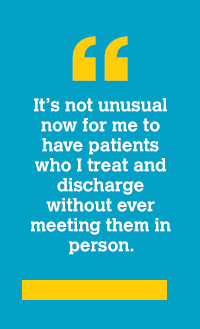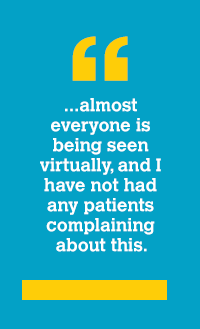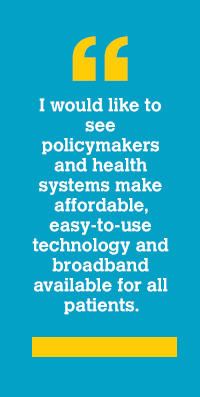The AACIPM team thought it would be interesting to ask Bob Twillman, PhD, FACLP, Pain Management Psychologist, Saint Luke’s Health System, some follow up questions about how telehealth has evolved one year after his last post on the topic. Through the questions, we are connecting timely issues related to pain management, mental health, and policy implications that matter to many.

Bob Twillman, PhD, FACLP, Pain Management Psychologist, Saint Luke’s Health System
Over a year into the COVID-19 pandemic, what has your experience been transitioning to telehealth? Has it gone better or worse than you initially expected?
I would say it has gone a little better than I expected. I was apprehensive at first that I might not be able to do some of the things I usually do with patients, such as teaching them relaxation/meditation exercises, but it turns out that I can do that just as well. I also had concerns about what would happen with the patients who I thought really benefitted from getting out of the house to come to this counseling appointment (before the pandemic)—some have done just as well while others continue to isolate, for both COVID-related and COVID-unrelated reasons. It’s not unusual now for me to have patients who I treat and discharge without ever meeting them in person.
Are you reverting back to in-person care, or do you anticipate reverting to in-person appointments with the majority of your patients?
 In June, I began seeing some patients in-person who required testing or had technology barriers. For example, when I evaluate a patient for a spinal cord stimulator or bariatric surgery, this requires psychological testing that needs to be given in-person. Additionally, I have a handful of patients unable to use technology, so I see them in-person as well. Aside from those few, almost everyone is being seen virtually, and I have not had any patients complaining about this. As long as insurance continues to pay at the same rate, I don’t anticipate changing the mix anytime soon. Besides, I really like the ability to work from home a couple of days a week!
In June, I began seeing some patients in-person who required testing or had technology barriers. For example, when I evaluate a patient for a spinal cord stimulator or bariatric surgery, this requires psychological testing that needs to be given in-person. Additionally, I have a handful of patients unable to use technology, so I see them in-person as well. Aside from those few, almost everyone is being seen virtually, and I have not had any patients complaining about this. As long as insurance continues to pay at the same rate, I don’t anticipate changing the mix anytime soon. Besides, I really like the ability to work from home a couple of days a week!
How has the transition to telehealth affected underserved populations? Are you seeing increased access to care due to the availability of telehealth options, or are you seeing decreased access due to technological barriers? How might this be addressed by policymakers and/or health systems?
This is a little difficult to answer since different patients in underserved settings have reacted differently. Let me explain. I believe that some patients I’m seeing with telehealth would not come in if in-person visits were required. Many of those are in outlying rural areas, where they might have to drive an hour or more to get to my office, and others see the benefits of not needing to take a half day off work just to come to my appointments. Alternatively, a couple patients who live in rural areas without reliable broadband access are coming for in-person sessions. And yet another perspective is with a few patients who couldn’t manage the technology and dropped out of therapy, even when offered telephone sessions (which, anecdotally, I don’t think are as effective).
 If policymakers and health systems could do two things, it would be to 1) make broadband available to patients in underserved settings, and 2) make inexpensive, easy-to-use technology available to patients who need it. For instance, there are some relatively inexpensive hot spot wifi connection points and small tablets, and a good economic analysis might well show that providing those still produces a net benefit for the healthcare system.
If policymakers and health systems could do two things, it would be to 1) make broadband available to patients in underserved settings, and 2) make inexpensive, easy-to-use technology available to patients who need it. For instance, there are some relatively inexpensive hot spot wifi connection points and small tablets, and a good economic analysis might well show that providing those still produces a net benefit for the healthcare system.
Since the onset of the COVID-19 pandemic, we know that rates of anxiety and depression have been increasing. We also know about the solid link between pain and mental health. In the past year, have you seen a change in demand for your services, and/or have you seen a change in the type of “person with pain” that comes to you for care?
I’m not sure I’ve really seen a change in the type of person being referred, or the prevalence of anxiety and depression. The thing I have seen, though, is that not being able to socialize has made addressing these challenges far more difficult for patients. For example, I used to see results when I could recommend and encourage gym memberships, pleasurable activities, and volunteer activities, but during the pandemic I haven’t been able to encourage things that involve contact with others. There has always been much more of a demand for pain management psychology services than the supply would allow, and that hasn’t changed appreciably.
In the early days of the pandemic, state and federal policymakers made it easier for patients to access telehealth by temporarily waiving many requirements related to in-person care. Have you seen any of these temporary waivers rolled back? Extended permanently? As both a thought leader and clinician in this field, what course of action should policymakers be taking?
 I don’t believe I’ve seen any of these waivers either rolled back or extended permanently. I have seen the development of something called PsyPact, which allows psychologists to practice across state lines in participating states, without needing to be licensed in the state where the patient is located. That raises some interesting enforcement issues, such as, how does a state investigate and potentially discipline a provider who is not licensed in that state, for something that happens with a patient in the state? Given that increased telehealth access is universally regarded as one of the success stories of the pandemic, I have a hard time imagining how policymakers and payers will be able to put this genie back into the bottle. We’ve always had evidence that some interventions are just as effectively delivered via telehealth as in person (with psychotherapy being a prime example), and we certainly should be seeing more evidence for other interventions now, so I hope the policymakers will take that to heart and facilitate our continuing to provide this kind of care.
I don’t believe I’ve seen any of these waivers either rolled back or extended permanently. I have seen the development of something called PsyPact, which allows psychologists to practice across state lines in participating states, without needing to be licensed in the state where the patient is located. That raises some interesting enforcement issues, such as, how does a state investigate and potentially discipline a provider who is not licensed in that state, for something that happens with a patient in the state? Given that increased telehealth access is universally regarded as one of the success stories of the pandemic, I have a hard time imagining how policymakers and payers will be able to put this genie back into the bottle. We’ve always had evidence that some interventions are just as effectively delivered via telehealth as in person (with psychotherapy being a prime example), and we certainly should be seeing more evidence for other interventions now, so I hope the policymakers will take that to heart and facilitate our continuing to provide this kind of care.
What has been your experience with insurers covering your services, as part of comprehensive pain care, via telehealth?
I have yet to encounter a problem with any payer covering my services. That means one of two things, I think: either they are paying for what I do, or our billing people are not telling me that we are not getting paid. I suspect the former. I haven’t really talked to other providers outside our system, but I have not heard a peep from within our system about mental health care being subjected to limitations by payers.
Related background from editors: Not directly related to pain, but related to mental health and telehealth: Policymakers around the nation have been adopting telehealth and mental health parity laws that require payers to reimburse telehealth encounters at the same rate as in-person encounters. Last year, Oklahoma passed landmark mental health parity legislation, stating that insurers may not apply nonquantitative treatment limitations with respect to mental health conditions and substance use disorders any more stringently than to medical and surgical benefits. Utah recently joined this movement by passing a law requiring payment parity for providers who conduct remote mental health visits. This expanded telehealth payment parity measures that Utah had implemented earlier in the pandemic, as mental health visits were not specifically included in their original telehealth parity provisions.
In our last discussion, you noted that while telehealth makes it possible for more patients to access your services, it doesn’t put more appointment slots on your calendar, and it doesn’t create any new pain management psychologists to see more patients. Have you seen any efforts by policymakers to address this shortage of providers? Do you have suggestions for policymakers and/or health systems?
This is another of the good news stories to come out of the pandemic. The challenge, as I see it, though, is that the supply hole for mental health care is so deep that this is not going to begin to really fill it. Right now, for a patient to be seen at a community mental health clinic in our area, they have to be acutely suicidal or homicidal—as in, practically needing to walk into the ED with a weapon threatening to harm themselves. For anything short of that, there just isn’t capacity, and building capacity is going to take a lot of time. Increasing the behavioral health workforce through education and training is not going to show any effect for at least three years, because that’s how long it takes most social work and professional counseling students to get through their training. For psychologists, it’s even longer—five years or more. It’s rather like the discussion we’re having in this country about infrastructure—we’ve neglected it for so long, that the fix is going to be massively expensive and take a decade or more to really implement.
Related background from editors: Not directly related to pain, but related to mental health: The federal government, aiming to address this need within the American Rescue Plan, just appropriated $100 million for behavioral health workforce education and training, $80 million for pediatric mental health care access, and $420 million for funding expansion grants for certified community behavioral health clinics. Given the connection between mental health and pain, how do you see this funding impacting people living with pain? Do you think that the funding for community behavioral health clinics will meaningfully expand access to underserved communities?
What are your thoughts on CE mandates specific to telehealth issues?
Further example from editors: In a recent comprehensive review of 249 publications analyzing ethical issues pertaining to the use of telehealth, therapist competence and need for special training, as well as clinical and therapeutic competencies specific to the online setting, were ranked as top concerns. With the unprecedented rise in the use of telehealth, do you see a corresponding need to ensure that practitioners have been trained in how to optimally and safely treat their patients with this new service delivery method?
I guess I’m in a different place than many others, especially those who are in independent practice, but these issues were worked out within our larger health system structure. We did do some work to ensure that we had processes in place for a number of contingencies, and we modified our documentation to reflect the new reality (e.g., new consent forms for patients, new note templates that included standard caveats related to telehealth, etc.). So, I don’t really feel like I needed much formal training, but I can see the value in it if you don’t have a large group of colleagues, risk management, and legal department colleagues helping you out.
Another example from editors: The Florida Board of Clinical Social Work, Marriage and Family Therapy and Mental Health Counseling, for example, requires three hours of CE relating to “professional ethics and boundary issues or telehealth” each licensure renewal period, while the Virginia Board of Counseling states that a “counselor should seek training or otherwise demonstrate expertise in the use of technology-assisted devices, especially in the matter of protecting confidentiality and security.” What are your thoughts on these new educational mandates?
I think that a suggestion/recommendation that those using telehealth service delivery seek CE specifically on that topic is appropriate. I wouldn’t even be opposed to a one-time requirement for a small number of hours on telehealth topics. I think we probably are going to need to wait and see if that needs to be an ongoing requirement for every renewal cycle. If we continue to use such high rates of telehealth delivery, which I certainly think is possible, it might be good to have a mandate to stay up to date on evolving technology and related legal/ethical issues. If, on the other hand, we see a big drop-off in the use of telehealth, then I think we could forgo a requirement. In other words, I guess I don’t feel strongly that it’s a bad idea, and I think it might be helpful for many.
We’ve recently heard about the use of telehealth to help health care providers to immediately identify stressors through remote patient monitoring devices, providing insights that aid clinicians in improving care and medication management. While a certain amount of remote monitoring has been happening for years (pacemakers, some diabetes management devices, cardiac monitors, CPAP machines) in various areas of healthcare, we’ve heard about significant expansions over the past year. Have you had any experience with real-time monitoring in your practice? Have your patients been receptive?
I don’t have any experience with real-time monitoring in my practice. I can see some utility in some types of monitoring, but I also worry about how you access only the minimum necessary information, and don’t end up with a whole lot of extraneous (private) information that you don’t need and shouldn’t have. For instance, if I’m working with a person with pain and we jointly decide that part of their treatment is to walk for 15 minutes a day, then objective data confirming that would be good to have. But if the same device tells me that that person is spending 5 hours a day in their local bar, should I be getting that information? What do I do with it, if I do get it? I think there need to be some safeguards built in to avoid unnecessary invasion of privacy, and, of course, the patient should be giving informed consent.
